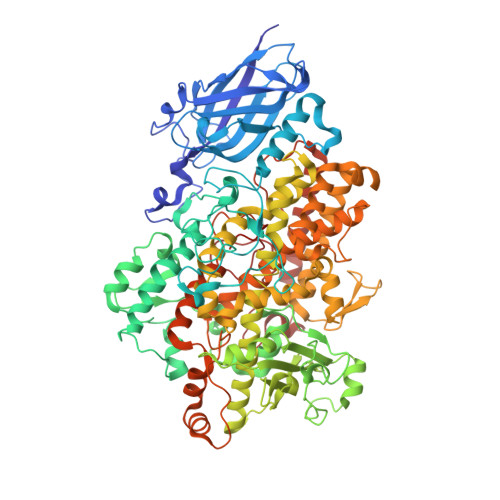Effect of crystal freezing and small-molecule binding on internal cavity size in a large protein: X-ray and docking studies of lipoxygenase at ambient and low temperature at 2.0 A resolution.
Skrzypczak-Jankun, E., BORBULEVYCH, O.Y., ZAVODSZKY, M.I., BARANSKI, M.R., PADMANABHAN, K., PETRICEK, V., JANKUN, J.(2006) Acta Crystallogr D Biol Crystallogr 62: 766-775
- PubMed: 16790932
- DOI: https://doi.org/10.1107/S0907444906016982
- Primary Citation of Related Structures:
1RRH, 1RRL - PubMed Abstract:
Flash-freezing is a technique that is commonly used nowadays to collect diffraction data for X-ray structural analysis. It can affect both the crystal and molecular structure and the molecule's surface, as well as the internal cavities. X-ray structural data often serve as a template for the protein receptor in docking calculations. Thus, the size and shape of the binding site determines which small molecules could be found as potential ligands in silico, especially during high-throughput rigid docking. Data were analyzed for wild soybean lipoxygenase-3 (MW 97 kDa) at 293 and 93 K and compared with the results from studies of its molecular complexes with known inhibitors, structures published by others for a derivative of the same enzyme (98 K) or a topologically close isozyme lipoxygenase-1 (at ambient temperature and 100 K). Analysis of these data allows the following conclusions. (i) Very small changes in the relative orientation of the molecules in the crystal can cause major changes in the crystal reciprocal lattice. (ii) The volume of the internal cavities can ;shrink' by several percent upon freezing even when the unit-cell and the protein molecular volume show changes of only 1-2%. (iii) Using a receptor structure determined based on cryogenic data as a target for computational screening requires flexible docking to enable the expansion of the binding-site cavity and sampling of the alternative conformations of the crucial residues.
Organizational Affiliation:
Urology Research Center, Medical University of Ohio, Toledo, OH 43614, USA. eskrzypczak@meduohio.edu















